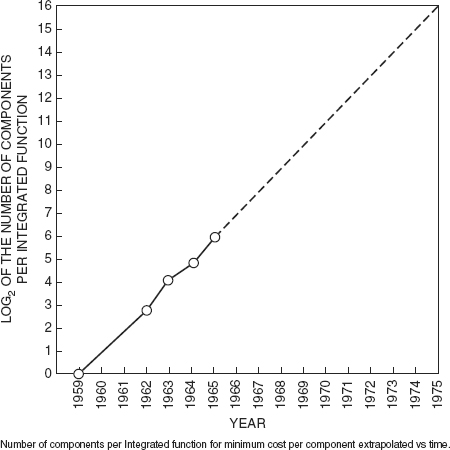1.8 PARTS AFFECTED BY OBSOLESCENCE PROBLEMS
Obsolescence events are projected to occur more often in the future due to the accelerating pace of innovations. In 1965, Gordon Moore, cofounder of Intel Corporation, noticed that the number of transistors that could be placed on an integrated circuit was doubling about every two years. Furthermore, he predicted that the trend would continue for at least ten years. This forecast (Figure 1-7) is now known as Moore’s Law, and advances in integrated circuits still follow it today (Intel, 2010b).
FIGURE 1-7 Graph of Moore’s Law created in 1965 (Intel, 2010b).

The frequent occurrence of obsolescence in electronics is due to their short procurement life cycles and because the effects on supportability and readiness are generally more immediate and apparent for electronic components. For nonelectronic components, obsolescence problems have generally been slower to develop, and drastic shifts in technology are not as common (Howard, 2002).
In summary, all types of product groups are affected by obsolescence. However, nonelectronic components typically remain supportable for decades, whereas electronic components may become obsolete in a matter of a few years or even months.
1.8.1 Electronic Part Obsolescence
Electronic part obsolescence is generally a result of the rapid growth of the electronics industry. As a result, many of the electronic ...
Get Strategies to the Prediction, Mitigation and Management of Product Obsolescence now with the O’Reilly learning platform.
O’Reilly members experience books, live events, courses curated by job role, and more from O’Reilly and nearly 200 top publishers.

